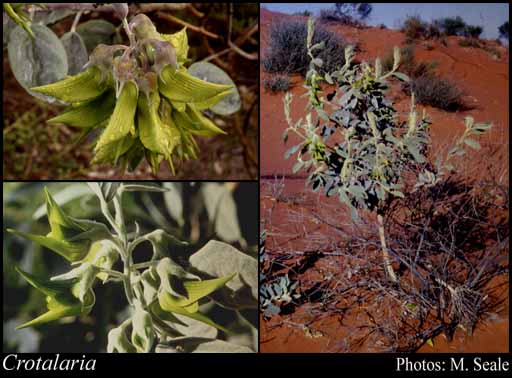- Reference
- Sp.Pl. [Linnaeus] 2:714 (1753)
- Name Status
- Current

Scientific Description
Family Papilionaceae. Crotalarieae.
Habit and leaf form. Shrubs, or herbs. The herbs annual, or biennial, or perennial; plants with neither basal nor terminal concentrations of leaves; to 0.3–3 m high. Helophytic, or mesophytic, or xerophytic. Leaves minute to very large; alternate; spiral, or distichous; not imbricate; petiolate to subsessile (usually), or sessile; non-sheathing; simple, or compound; pulvinate (usually), or epulvinate; when compound unifoliolate, or ternate, or palmate. Leaves when trifoliolate, palmately trifoliolate. Leaflets 1, or 3(–7); not stipellate; pulvinate, or epulvinate. Leaf blades dorsiventral, or isobilateral, or centric. Leaves with stipules (usually), or without stipules (? — sometimes ‘small or absent’). Stipules intrapetiolar; adnate to the petiole to free of the petiole (sometimes decurrent); when present, scaly (or filiform), or leafy; caducous, or persistent. Leaves without a persistent basal meristem. Leaf anatomy. Hairs present; glandular hairs absent; complex hairs absent. Branched hairs absent. Stem anatomy. Nodes tri-lacunar, or penta-lacunar. Secondary thickening absent, or developing from a conventional cambial ring.
Reproductive type, pollination. Fertile flowers hermaphrodite. Unisexual flowers absent. Plants hermaphrodite. Entomophilous.
Inflorescence and flower features. Flowers aggregated in ‘inflorescences’ (usually), or solitary (rarely); in racemes, or in spikes, or in heads, or in fascicles (rarely). The terminal inflorescence unit racemose (usually), or cymose. Inflorescences terminal, or axillary, or leaf-opposed. Flowers bracteate (usually small, sometimes leafy), or ebracteate. Bracts usually persistent. Flowers bracteolate (usually, the bracteoles inserted on the calyx or just below it), or ebracteolate. Bracteoles usually persistent. Bracteoles adnate to the receptacle to not adnate to the receptacle. Flowers minute to large; very irregular; zygomorphic. The floral asymmetry involving the perianth, or involving the perianth and involving the androecium. Flowers papilionaceous (imbricate-descending, with the posterior petal outside and forming a flag (‘standard’)); basically 5 merous. Floral receptacle developing a gynophore, or with neither androphore nor gynophore; usually more or less cupular. Free hypanthium present, or absent. Perianth with distinct calyx and corolla; 10; 2 -whorled; isomerous. Calyx present; 5; 1 -whorled; gamosepalous. Calyx lobes about the same length as the tube, or markedly longer than the tube. Calyx imbricate, or valvate; regular (usually, more or less), or unequal but not bilabiate, or bilabiate (infrequently, when the posterior pair forming a lip); persistent; with the median member anterior. Epicalyx present (representing adnate bracteoles), or absent. Corolla present; 5; 1 -whorled; appendiculate (usually auriculate), or not appendiculate. Standard not appendaged (but often auriculate/callose above its short claw). Corolla partially gamopetalous. 2 of the petals joined (the two ventral petals connivent to form the ‘keel’). The joined petals of the papilionate corolla anterior. The wings of the corolla free from the keel; not laterally spurred. Standard ‘normally’ developed (orbicular or rarely ovate). Keel usually conspicuously exceeding the wings, or about equalling the wings to conspicuously exceeding the wings; long-acuminate and beaked (the beak often twisted); coiled or spiralled to neither coiled nor spiralled (often twisted); bent at right angles and beaked, or not bent and beaked (but beaked, and usually more or less incurved). Corolla imbricate (descending); plain, or with contrasting markings (e.g. with brown, purple or red streaks); yellow (usually, often concolorously so), or yellow and orange, or yellow and brown, or green and yellow, or blue (or mauve, rarely); persistent, or deciduous. Petals clawed. Androecial members definite in number. Androecium 10. Androecial sequence determinable, or not determinable. Androecial members free of the perianth; markedly unequal; coherent (the filaments united basally into an adaxially split tube); 1 - adelphous. The staminal tube free from the keel petals. Androecial members 1 -whorled (even though diplostemonous). Androecium exclusively of fertile stamens. Stamens 10; all more or less similar in shape, or distinctly dissimilar in shape (usually); diplostemonous; both opposite and alternating with the corolla members. Anthers separate from one another, or connivent; dimorphic (usually, alternately small and dorsifixed, long and basifixed); alternately dorsifixed and basifixed; usually, alternately versatile and non-versatile; dehiscing via longitudinal slits; latrorse, or introrse; tetrasporangiate. Gynoecium 1 carpelled. The pistil 1 celled. Carpels reduced in number relative to the perianth. Gynoecium monomerous; of one carpel; superior. Carpel stylate; apically stigmatic. Style (in-) curved, or bent. Style bearded via an apical ring, or bearded down one side, or hairy but not bearded, or glabrous. Carpel 2–100 ovuled (i.e. to ‘many’). Placentation marginal (along the ventral suture). Gynoecium median (the placenta posterior, on the ventral suture). Ovary sessile (usually), or subsessile to stipitate. Ovules pendulous to ascending; biseriate; arillate; anatropous, or campylotropous to amphitropous, or hemianatropous.
Fruit and seed features. Fruit stipitate to sessile; non-fleshy; hairy, or not hairy. The fruiting carpel dehiscent; a legume. Pods globose to much elongated (globose or oblong to cylindrical); not triangular; straight; beaked, or not beaked; becoming inflated (usually), or not becoming inflated; somewhat compressed, or terete; regularly constricted between adjacent seeds, or irregularly constricted; not transversely septate; wingless. Valves of the dehisced pod twisted, or not twisted. Fruit 1 celled; elastically dehiscent, or passively dehiscent. Dispersal unit the seed. Fruit 2–100 seeded (to ‘many’). Seeds more or less reniform; endospermic, or non-endospermic; not mucous; compressed; small to very large; arillate, or non-arillate. Cotyledons 2; accumbent. Embryo chlorophyllous; curved to bent (the radicle incurved). Testa non-operculate. Micropyle zigzag, or not zigzag. Seedling. Germination phanerocotylar.
Physiology, biochemistry. Nitrogen-fixing root nodules present. Aluminium accumulation not found. Photosynthetic pathway: C3.
Geography, cytology, number of species. Native of Australia and adventive. 2n= 14, 16, (32). A genus of about 600 species; 33 species in Western Australia.